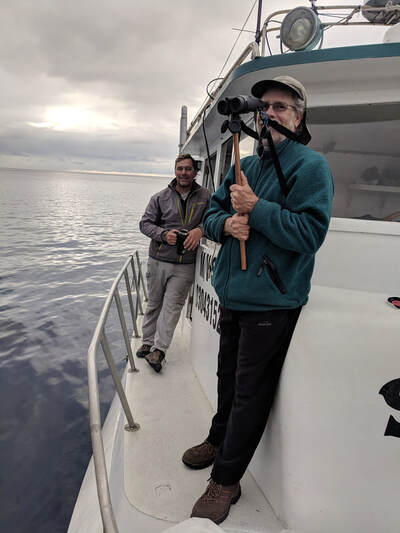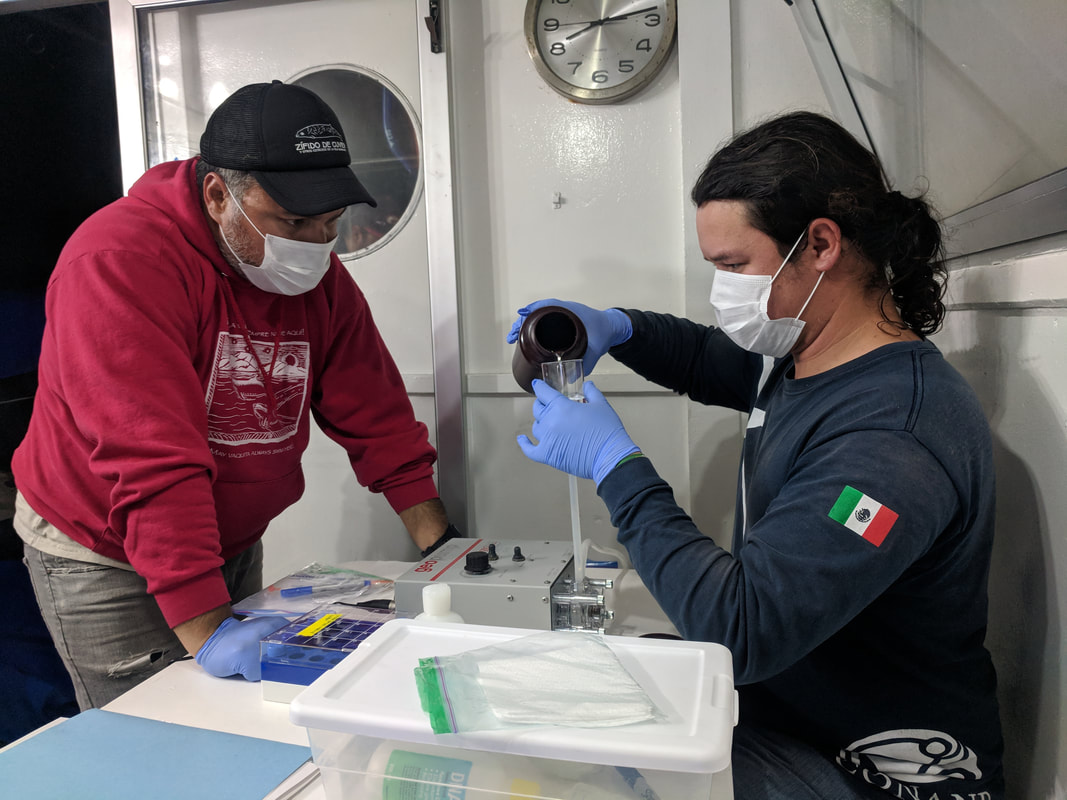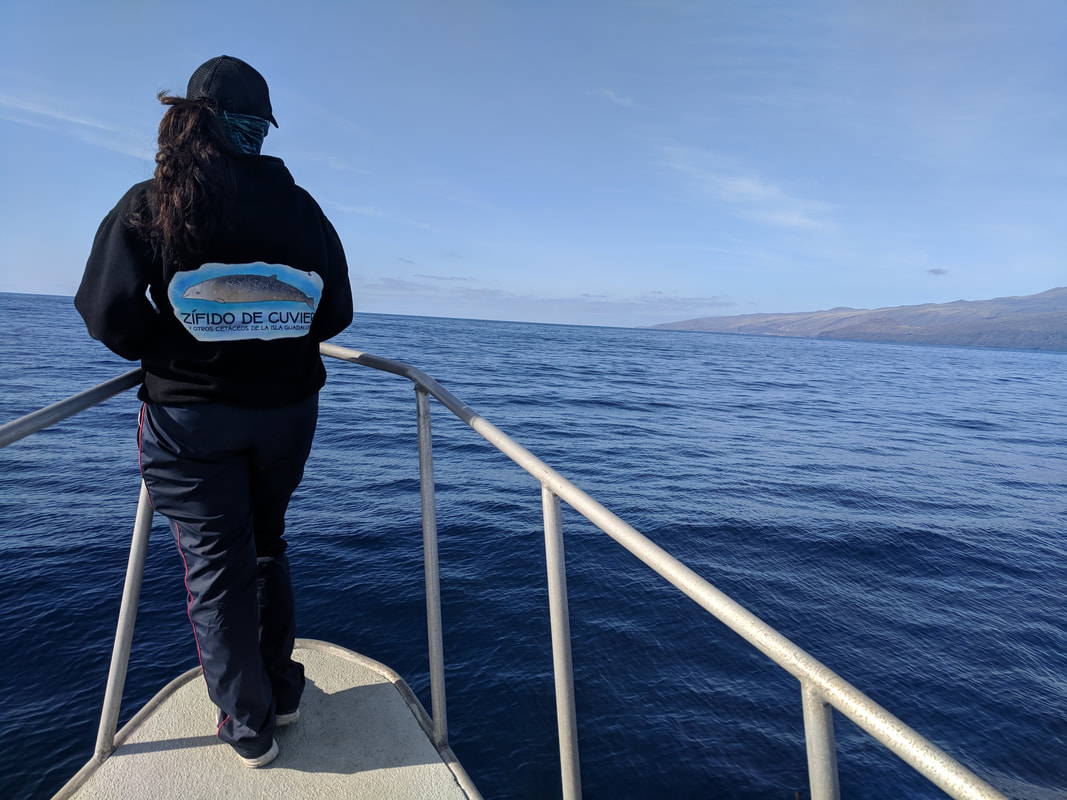|
During May 2019, we completed our second field effort of the Guadalupe Island comparative study. This work is in collaboration with our colleagues Gustavo Cárdenas-Hinojosa, Lorenzo Rojas Bracho, and Andrea Bonilla. To learn about the background on this project and the results from our first field effort, check out our previous blog post here. In typical island magic, our trip started out with a bang. After picking up the panga from Campo Oeste, we headed to the north end of the island on the east side to Bahía Norte. It was a windy day and as we tucked into the small lee of the bay, Brenda was searching to the stern just at a group of five Cuvier’s beaked whales broke the surface about 300 meters away. Thank you for delivering immediately, Guadalupe Island! The weather was surprisingly poor throughout our trip. We had a lot of wind. We had rain. We had cold. Down jackets may have been worn on numerous occasions (it was over 40 degrees colder than Washington at times). The upside was that with rain comes beautiful rainbows. So, we’ve established the weather was poor BUT in spite of this, the trip was quite successful and it is not often one can say this--which should help explain how truly unique and special this place is. Despite several attempts to make it offshore or south, we were always forced back into what we referred to as our “postage stamp” of a survey area within Bahía Norte. Fortunately, this is a hot spot for whale activity. Often times, we would just drop anchor, stand watch and patiently wait for the animals to come to us. Brenda and Greg were enjoying this method tremendously since the work off San Clemente Island, California requires approximately 180 kilometers of surveying (with no protection from the weather) and does not always result in beaked whale sightings. In the nine days we spent at the island, we deployed four location and dive behavior LIMPET satellite tags on two adult males, one female with an older calf, and one sub-adult. This now brings the project total to eight tags deployed. Thanks to the skilled eyes and memory of Andrea, we were able to get immediate identifications of individuals, an incredible asset for this project for a number of reasons, one of which is for selecting candidates for tagging and biopsy. We had several resightings from our October 2018 survey including a female with a new calf. In fact, we documented several mom/calf pairs including two mom/neonates (recently born with fetal folds still visible)! In total, we had 38 sightings of 111 individuals with many of these being resights of the same individuals throughout the survey. We are looking forward to the photo-ID results once Andrea, Erin Keene (MarEcoTel), Brenda and Erin Falcone (MarEcoTel) have processed and matched the images to the Guadalupe and California catalogs. We collected a number of eDNA water and biopsy samples. We were also very fortunate to have Jay Barlow from Southwest Fisheries Science Center onboard with us. Several acoustic devices were deployed during the transits to and from Ensenada and while working in Bahía Norte. On the very last day when we had to return the panga and were limited by time due to the tides, we finally had the first calm, windless day (of course). We ran the canyon offshore and within a short time we had two Cuvier’s sightings totaling three animals. Only one animal was close enough for a photo and we identified it as a new animal for the trip and a resighting from our October survey. Just a side jaunt out from the island proved quite fruitful. We can only imagine what we would have found if we had more weather windows during this trip. While returning the panga, we were fortunate to have an opportunity to meet the director of the Biosphere Reserve, Marisol Torres. Our next field effort off Guadalupe Island will be in September. We would like to thank our funder, the Office of Naval Research. Thank you to Marisol Torres, Director of the Biosphere Reserve who supports our work in the Reserve. Thank you to Raul Urias and the community of Campo Oeste for providing an excellent panga and help with logistics. Thank you to Scott Carnahan, owner of M/V Storm, for continuing to support our research and providing a stellar research platform, Captain and crew. Thank you to Frank and Jane Falcone for supporting our work in all the ways they continue to do so. Without all of these organizations and people, this work would not be possible. Last, but certainly not least, we would like to thank everyone involved in this survey. MarEcoTel feels very lucky to have the opportunity to work with such kind, enthusiastic, smart people and they all made this trip phenomenal.  From Left down to Right up: Celso Nieto (engineer), Brenda Rone (MarEcoTel), Daniel Martinez (CONANP), Martin Rodriguez (fisherman), Andrea Bonilla (Oceanides), Gustavo Cárdenas-Hinojosa (CONABIO), Jay Barlow (SWFSC), Noé Lucero (Captain), Olegario León (cook), Greg Schorr (MarEcoTel), Tony Rielas (mate). Photo: Gregory S. Schorr AuthorBrenda Rone
145 Comments
|
AuthorClick here to learn about our research staff. Archives
August 2022
Categories |
Proudly powered by Weebly
















 RSS Feed
RSS Feed